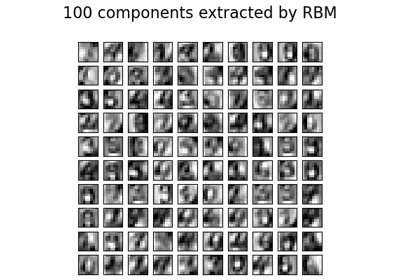sklearn.neural_network.BernoulliRBM¶
-
class
sklearn.neural_network.BernoulliRBM(n_components=256, *, learning_rate=0.1, batch_size=10, n_iter=10, verbose=0, random_state=None)[source]¶ Bernoulli Restricted Boltzmann Machine (RBM).
A Restricted Boltzmann Machine with binary visible units and binary hidden units. Parameters are estimated using Stochastic Maximum Likelihood (SML), also known as Persistent Contrastive Divergence (PCD) [2].
The time complexity of this implementation is
O(d ** 2)assuming d ~ n_features ~ n_components.Read more in the User Guide.
- Parameters
- n_componentsint, default=256
Number of binary hidden units.
- learning_ratefloat, default=0.1
The learning rate for weight updates. It is highly recommended to tune this hyper-parameter. Reasonable values are in the 10**[0., -3.] range.
- batch_sizeint, default=10
Number of examples per minibatch.
- n_iterint, default=10
Number of iterations/sweeps over the training dataset to perform during training.
- verboseint, default=0
The verbosity level. The default, zero, means silent mode.
- random_stateinteger or RandomState, default=None
Determines random number generation for:
Gibbs sampling from visible and hidden layers.
Initializing components, sampling from layers during fit.
Corrupting the data when scoring samples.
Pass an int for reproducible results across multiple function calls. See Glossary.
- Attributes
- intercept_hidden_array-like, shape (n_components,)
Biases of the hidden units.
- intercept_visible_array-like, shape (n_features,)
Biases of the visible units.
- components_array-like, shape (n_components, n_features)
Weight matrix, where n_features in the number of visible units and n_components is the number of hidden units.
- h_samples_array-like, shape (batch_size, n_components)
Hidden Activation sampled from the model distribution, where batch_size in the number of examples per minibatch and n_components is the number of hidden units.
References
- [1] Hinton, G. E., Osindero, S. and Teh, Y. A fast learning algorithm for
deep belief nets. Neural Computation 18, pp 1527-1554. https://www.cs.toronto.edu/~hinton/absps/fastnc.pdf
- [2] Tieleman, T. Training Restricted Boltzmann Machines using
Approximations to the Likelihood Gradient. International Conference on Machine Learning (ICML) 2008
Examples
>>> import numpy as np >>> from sklearn.neural_network import BernoulliRBM >>> X = np.array([[0, 0, 0], [0, 1, 1], [1, 0, 1], [1, 1, 1]]) >>> model = BernoulliRBM(n_components=2) >>> model.fit(X) BernoulliRBM(n_components=2)
Methods
fit(X[, y])Fit the model to the data X.
fit_transform(X[, y])Fit to data, then transform it.
get_params([deep])Get parameters for this estimator.
gibbs(v)Perform one Gibbs sampling step.
partial_fit(X[, y])Fit the model to the data X which should contain a partial segment of the data.
Compute the pseudo-likelihood of X.
set_params(**params)Set the parameters of this estimator.
transform(X)Compute the hidden layer activation probabilities, P(h=1|v=X).
-
__init__(n_components=256, *, learning_rate=0.1, batch_size=10, n_iter=10, verbose=0, random_state=None)[source]¶ Initialize self. See help(type(self)) for accurate signature.
-
fit(X, y=None)[source]¶ Fit the model to the data X.
- Parameters
- X{array-like, sparse matrix} of shape (n_samples, n_features)
Training data.
- Returns
- selfBernoulliRBM
The fitted model.
-
fit_transform(X, y=None, **fit_params)[source]¶ Fit to data, then transform it.
Fits transformer to X and y with optional parameters fit_params and returns a transformed version of X.
- Parameters
- X{array-like, sparse matrix, dataframe} of shape (n_samples, n_features)
- yndarray of shape (n_samples,), default=None
Target values.
- **fit_paramsdict
Additional fit parameters.
- Returns
- X_newndarray array of shape (n_samples, n_features_new)
Transformed array.
-
get_params(deep=True)[source]¶ Get parameters for this estimator.
- Parameters
- deepbool, default=True
If True, will return the parameters for this estimator and contained subobjects that are estimators.
- Returns
- paramsmapping of string to any
Parameter names mapped to their values.
-
gibbs(v)[source]¶ Perform one Gibbs sampling step.
- Parameters
- vndarray of shape (n_samples, n_features)
Values of the visible layer to start from.
- Returns
- v_newndarray of shape (n_samples, n_features)
Values of the visible layer after one Gibbs step.
-
partial_fit(X, y=None)[source]¶ Fit the model to the data X which should contain a partial segment of the data.
- Parameters
- Xndarray of shape (n_samples, n_features)
Training data.
- Returns
- selfBernoulliRBM
The fitted model.
-
score_samples(X)[source]¶ Compute the pseudo-likelihood of X.
- Parameters
- X{array-like, sparse matrix} of shape (n_samples, n_features)
Values of the visible layer. Must be all-boolean (not checked).
- Returns
- pseudo_likelihoodndarray of shape (n_samples,)
Value of the pseudo-likelihood (proxy for likelihood).
Notes
This method is not deterministic: it computes a quantity called the free energy on X, then on a randomly corrupted version of X, and returns the log of the logistic function of the difference.
-
set_params(**params)[source]¶ Set the parameters of this estimator.
The method works on simple estimators as well as on nested objects (such as pipelines). The latter have parameters of the form
<component>__<parameter>so that it’s possible to update each component of a nested object.- Parameters
- **paramsdict
Estimator parameters.
- Returns
- selfobject
Estimator instance.

